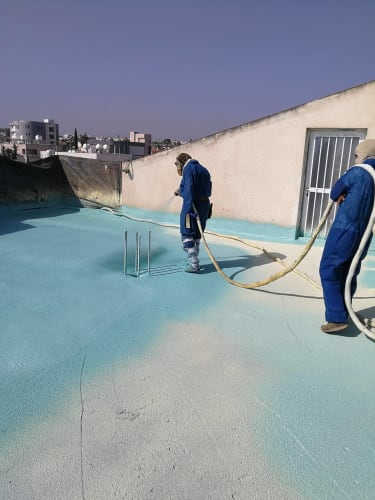Polyurethane

Polyurethane foam is the chemical effect of the isocyanate and polyol compound. It is one of the best thermal insulation materials, versatile, modern and safe.
It has the lowest coefficient of thermal conductivity (λ = 0.028 W / m * K) of all other thermal insulation materials on the world market.
It has no joints, eliminates thermal bridges and significantly reduces the energy consumption of the building for heating and cooling by at least 40-45%, and offers 4-5 ° C lower indoor temperature.
Its uses are unlimited!
It is applied to any surface, even in the most difficult and demanding applications.
Especially in the construction industry, where thermal insulation, waterproofing and sound insulation are required, polyurethane foam is the ideal material that can give excellent results and high performance.
It is applied directly, with special spraying equipment, directly on the space in successive layers (horizontal, vertical, inverted) to the desired thickness, on roofs, tiled roofs, perimeter walls, metal structures, etc. or by injection into walls.
It dries in seconds!
It is the ideal solution for thermal insulation of homes, workplaces, cold rooms, food storage booths, livestock and poultry farms, factories, etc. It is also suitable for old constructions as it does not add weight to the load-bearing structure of the building.
Polyurethane should not be exposed to sunlight, so it is necessary to cover it with any coating such as (simple acrylic paint or polyurethane paint or polyurea or tile coating).
Properties
Thermal insulation
Polyurethane foam (closed or open cells) is one of the most effective thermal insulation materials due to its low thermal conductivity and high strength.
The excellent thermal insulation capacity of the polyurethane foam, sprayed and injected is enhanced by the fact of their uniform and without application joints that seal hermetically, eliminating the thermal bridges.
Waterproofing
Closed cell polyurethane foam, in addition to thermal insulation, is also waterproof, which sets it apart from other thermal insulation materials. It does not absorb water and because it is applied continuously and adheres to the support structure, it acts as a waterproof barrier, protecting it from water penetration.
Sound insulation
The sprayed polyurethane foam (open cells) is applied uniformly and acquires absolute adhesion to the support structure, thus creating an effect of sealing, thermal insulation and sound insulation from airborne noises.
Fire resistance
Polyurethane foam is an organic material and, like most building materials, has a certain degree of fire resistance. Unlike other plastics, polyurethane foam is a thermostable product. It does not melt and in case of charring it does not dissolve.
Impact on Man and the Environment
Polyurethane foam is harmless to human health, as demonstrated by its applications. Once applied, it remains inactive throughout its useful life and does not produce harmful emissions.
During the spraying process of polyurethane foam, a chemical reaction takes place between the two components that make it up (polyol and isocyanate), which is why professional applicators use the appropriate protection equipment.
Summary of Advantages
- Reduction of CO2 emissions.
- It is applied winter - summer.
- Zero ozone load.
- Application in old constructions.
- Load resistance. It does not crack.
- Resistance to extreme weather conditions.
- Resistance to very low / high temperatures.
- Long service life with zero maintenance.
- Perfect adhesion to the applied surface.
- It is applied on vertical surfaces but also inverted.
- Minimizes failures as there are no joints and joints.
- Full compliance with applicable fire safety regulations.
- Possibility of thermal insulation, sound insulation and waterproofing in one application.
- Speed of application, large surfaces can be covered in a short time.
